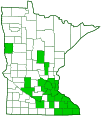European paper wasp
(Polistes dominula)
Conservation • Description • Habitat • Ecology • Distribution • Taxonomy
Conservation Status |
|
|||||||
| IUCN Red List | not listed |
|||||||
| NatureServe | NNA - Not applicable |
|||||||
| Minnesota | not listed |
|||||||
Description |
||
European paper wasp is a common, exotic, predatory, social wasp. It is native to Europe, Asia, and northwest Africa. It is the most common Polistes species in Europe. It has been introduced into North America, South America, and Australia. It was first recorded in the United States in Cambridge, Massachusetts in 1978. Since then, it has spread across the United States and southern Canada. It is most common in the northeast, the Upper Midwest, the Pacific Northwest, and California. It is uncommon to rare in the southernmost tier of states and in the Great Plains. Adults are large and black with yellow markings. They are often misidentified as yellowjackets. Their size is usually given in terms of forewing length. Females have a ⅜″ to ½″ (9.5 to 13.0 mm) forewing length. The front part of the body (mesosoma) is connected to the rear part (metasoma) by a narrow waist. There are two large compound eyes on the sides of the head and three small simple eyes (ocelli) in a triangle at the top of the head between the compound eyes. The yellow stripe behind each compound eye when viewed from the side is usually broadly interrupted in the middle, creating two separated yellow spots, or is sometimes complete but strongly narrowed in the middle. The large plate on the face (clypeus) is triangular and yellow. It usually has a well-developed black spot in the middle, often a smaller black spot on each side, but is entirely yellow on some individuals. The lower margin of the clypeus is triangular and pointed at the tip. The jaws (mandibles) are black, sometimes with a yellow spot. The area between the compound eye and the mandible (malar space) is yellow and connects with the yellow behind the compound eye. The antennae have 12 segments, including a long basal segment (scape), a short second segment (pedicel), and the whip-like end section (flagellum) with 10 segments (flagellomeres). The upper sides of the scape and pedicel, and the basal two-thirds of the first flagellomere, are black. The underside of the scape is yellow. The underside of the pedicel, the tip and underside of the first flagellomere, and both sides of the remaining flagellomeres, are orange. This is the most easily distinguishing feature of this species. The thorax is black and has three segments, from front to back the prothorax, mesothorax, and metathorax. However, the first segment of the abdomen (propodeum) is fused to the thorax, giving the thorax the appearance of having four segments. The upper plate on the prothorax (pronotum) is short and collar-like. It extends rearward on the sides to the plate at the base of each wing (tegula). It appears horseshoe-shaped when viewed from above, triangular when viewed from the side. It is mostly black except for a yellow band on the front margin and a narrow yellow stripe on each inner margin. On the mesothorax, the large front plate (mesoscutum or scutum) has a pair of yellow comma-shaped marks toward the front. On the upper surface of the metathorax (metanotum) there is a pair of small spots that are sometimes joined into a narrow stripe. There is also a pair of large spots on the propodeum. The tegulae are yellow. The first segment (tergite) of the metasoma (T1) is somewhat narrowed but not petiole-like. It is black with a yellow band at the rear and a yellow spot on each side. The band has a narrow notch in the middle. T2 has a pair of large yellow spots. The remaining tergites each have a band at the rear with a narrow notch in the middle and a broader depression on each side. The legs are long. On each leg the first segment (coxa), second segment (trochanter), and the basal two-thirds of the third segment (femur) are black. The end of the femur, the fourth segment (tibia), and the last part of the leg (tarsus), corresponding to the foot, are yellow. On the middle leg the tibia has two spurs at the end. The claws at the end of the tarsus are simple, not forked. The wings are smoky and clear. When at rest they are folded over the body. The forewing has three submarginal cells. The first discoidal cell is very long, about half as long as the entire wing. On the hind wing the jugal lobe is small. Males are slightly smaller, with a 5⁄16″ to ½″ (8.5 to 12.0 mm) forewing length. The clypeus is entirely yellow. The antennae have 13 segments. On T1 the yellow spots always touch the yellow band at the rear. There is a yellow mark on the underside of the coxae always on the front legs, often on the middle legs, and sometimes on the rear legs. |
||
Size |
||
Female forewing length: ⅜″ to ½″ (9.5 to 13.0 mm) Male forewing length: 5⁄16″ to ½″ (8.5 to 12.0 mm) |
||
Similar Species |
||
Habitat |
||
|
||
Ecology |
||
Season |
||
|
||
Behavior |
||
|
||
Life Cycle |
||
|
||
Larva Food |
||
North American Polistes species use only caterpillars to feed their offspring. European paper wasp is a generalist feeder, using insects from three insect orders. |
||
Adult Food |
||
Flower nectar |
||
Distribution |
||||
|
Sources |
|||
| 12/30/2022 | ||||
Occurrence |
||||
Common |
||||
Taxonomy |
|||
Order |
Hymenoptera (Ants, Bees, Wasps, and Sawflies) | ||
Suborder |
Apocrita (Narrow-waisted Wasps, Ants, and Bees) | ||
Infraorder |
Aculeata (Ants, Bees, and Stinging Wasps) | ||
Superfamily |
Vespoidea (vespoid wasps) | ||
Family |
Vespidae (hornets, paper wasps, potter wasps, and allies) | ||
Subfamily |
Polistinae (paper wasps) | ||
Tribe |
Polistini | ||
Genus |
Polistes (typical paper wasps) | ||
| Subgenus | Polistes | ||
Synonyms |
|||
Polistes dominulus Polistes italica Polistes maculatus Polistes pectoralis Vespa dominula |
|||
Common Names |
|||
European paper wasp |
|||
Glossary
Clypeus
On insects, a hardened plate on the face above the upper lip (labrum).
Femur
On insects and arachnids, the third, largest, most robust segment of the leg, coming immediately before the tibia. On humans, the thigh bone.
Flagellomere
A segment of the whip-like third section of an insect antenna (flagellum).
Malar space
In Hymenoptera, the space, equivalent to the cheek, between the bottom of the compound eye and the base of the mandible.
Pronotum
The exoskeletal plate on the upper side of the first segment of the thorax of an insect.
Scape
In plants: An erect, leafless stalk growing from the rootstock and supporting a flower or a flower cluster. In insects: The basal segment of the antenna.
Scutum
The forward (anterior) portion of the middle segment of the thorax (mesonotum) in insects and some arachnids.
Tarsus
On insects, the last two to five subdivisions of the leg, attached to the tibia; the foot. On spiders, the last segment of the leg. Plural: tarsi.
Tegula
A small, hardened, plate, scale, or flap-like structure that overlaps the base of the forewing of insects in the orders Lepidoptera, Hymenoptera, Diptera, and Homoptera. Plural: tegulae.
Tergite
The upper (dorsal), hardened plate on a segment of the thorax or abdomen of an arthropod or myriapod.
Tibia
The fourth segment of an insect leg, after the femur and before the tarsus (foot). The fifth segment of a spider leg or palp. Plural: tibiae.
Visitor Photos |
|||||
Share your photo of this insect. |
|||||
| This button not working for you? Simply email us at info@MinnesotaSeasons.com. Attach one or more photos and, if you like, a caption. |
|||||
Alfredo Colon |
|||||
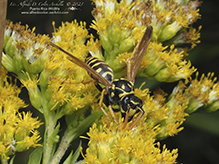 |
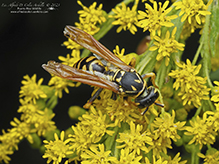 |
||||
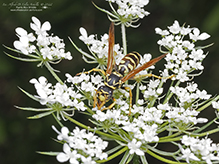 |
|||||
Babette Kis |
|||||
Polistes dominula (European paper wasp) |
|||||
Polistes dominula Barnes Prairie, by the hedgerow, Racine Co., WI June 1 2021 |
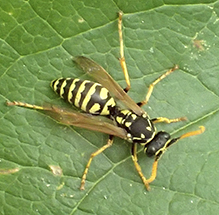 |
||||
Polistes dominula Barnes Prairie house next to Racine Co., WI July 22 2021 |
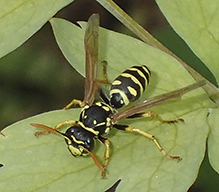 |
||||
Polistes dominula Barnes Prairie Hedgerow Sept. 23 2021 |
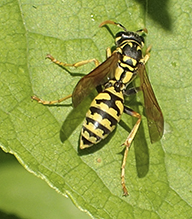 |
||||
MinnesotaSeasons.com Photos |
|||||
|
|||||

Visitor Videos |
|||
Share your video of this insect. |
|||
| This button not working for you? Simply email us at info@MinnesotaSeasons.com. Attach a video, a YouTube link, or a cloud storage link. |
|||
Other Videos |
|||
| European Paper Wasp: Polistes dominula EntomologistJed |
|||
About
Sep 7, 2020 Entomologist Jed discusses aggressive behaviors in the European Paper Wasp while examining a nest. |
|||


Created: 12/30/2022
Last Updated:
